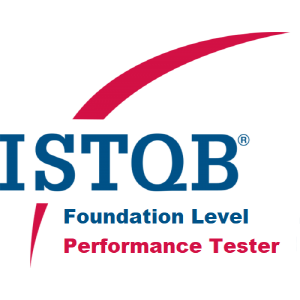
ISTQB FOUNDATION – PERFORMANCE TESTER certificate offers an introduction to the fundamentals of Software Performance Testing.
Performance efficiency (or simply “performance”) is an essential part of providing a“good experience” for users when they use their applications on a variety of fixed and mobile platforms. Performance testing plays a critical role in establishing acceptable quality levels for the end user and is often closely integrated with other disciplines such as usability engineering and performance engineering.
Business Objectives
- Understand the basic concepts of performance efficiency and performance testing.
- Define performance risks, goals, and requirements to meet stakeholder needs and expectations.
- Understand performance metrics and how to collect them.
- Develop a performance test plan for achieving stated goals and requirements.
- Conceptually design, implement, and execute basic performance tests.
- Analyze the results of a performance test and state implications to various stakeholders.
- Explain the process, rationale, results, and implications of performance testing to various stakeholders.
- Understand categories and uses for performance tools and criteria for their selection.
- Determine how performance testing activities align with the software lifecycle.
Prerequisites
Participants must have a ISTQB Foundation Certified Tester certification to sit the exam
Contents
1. Basic Concepts
1.1 Principles of Performance Testing
1.2 Types of Performance Testing
1.3 Testing Types in Performance Testing
1.3.1 Static testing
1.3.2 Dynamic testing
1.4 The Concept of Load Generation
1.5 Common Performance Efficiency Failure Modes and Their Causes
2. Performance Measurement Fundamentals
2.1 Typical Metrics Collected in Performance Testing
2.1.1 Why Performance Metrics are Needed
2.1.2 Collecting Performance Measurements and Metrics
2.1.3 Selecting Performance Metrics
2.2 Aggregating Results from Performance Testing
2.3 Key Sources of Performance Metrics
2.4 Typical Results of a Performance Test
3. Performance Testing in the Software Lifecycle
3.1 Principal Performance Testing Activities
3.2 Categories of Performance Risks for Different Architectures
3.3 Performance Risks Across the Software Development Lifecycle
3.4 Performance Testing Activities
4. Performance Testing Tasks
4.1 Planning
4.1.1 Deriving Performance Test Objectives
4.1.2 The Performance Test Plan
4.1.3 Communicating about Performance Testing
4.2 Analysis, Design and Implementation
4.2.1 Typical Communication Protocols
4.2.2 Transactions
4.2.3 Identifying Operational Profiles
4.2.4 Creating Load Profiles
4.2.5 Analyzing Throughput and Concurrency
4.2.6 Basic Structure of a Performance Test Script
4.2.7 Implementing Performance Test Scripts
4.2.8 Preparing for Performance Test Execution
4.3 Execution
4.4 Analyzing Results and Reporting
5. Tools
5.1 Tool Support
5.2 Tool Suitability
Exam Details
The Foundation Level Performance Testing exam is comprised of 40 multiple-choice questions, with a pass mark grade of 65% to be completed within 60 minutes. Participants that take the exam not in their spoken language, will receive additional 25% time, and will have 15 minutes more, or a total of 75 min.
